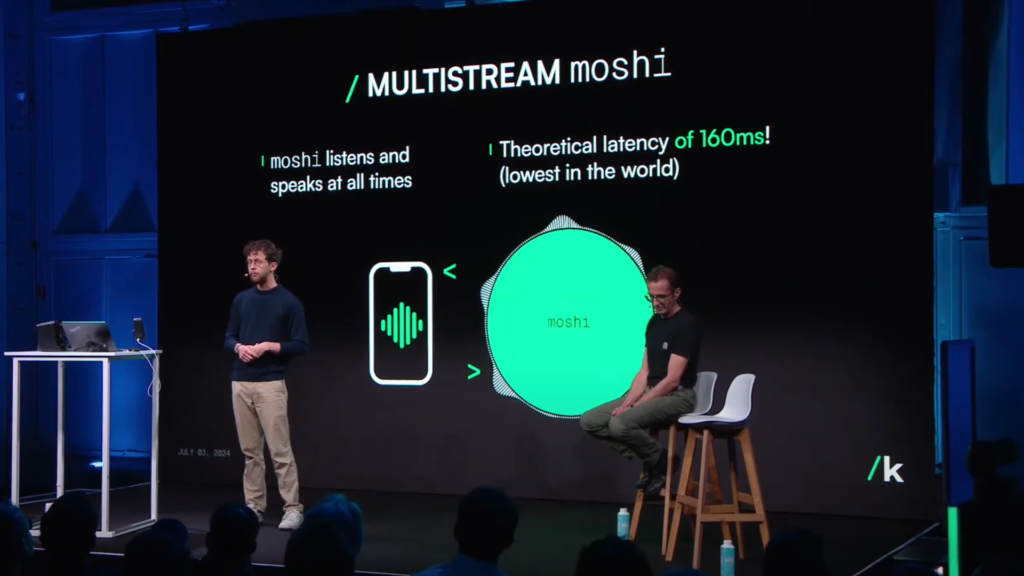It seems that in the modern world of constant advancement in technological sciences, a new competitor appears on the scene. Let us introduce you to a truly revolutionary product – Moshi, an AI chatbot designed by the French-based Kyutai. Moshi is, therefore, promising to change the way society handles AI through its excellent working speed and variety of functions.

The Story Behind Moshi
The rise of Moshi is tied to a vision of making AI more open and accessible. Unlike AI giants such as OpenAI or Google, Kyutai functions as a nonprofit laboratory. It is backed by prominent French entrepreneurs Xavier Niel and Rodolphe Saadé, who wanted to ensure Europe contributes significantly to AI research.
Launched in 2024, Moshi reflects this philosophy. It is open-source, meaning researchers and developers worldwide can study its architecture, experiment, and build upon it. This contrasts with closed models like ChatGPT or Gemini, which keep their systems private.
The name “Moshi” itself resonates with communication. In Japanese, “moshi moshi” is a friendly way of saying hello over the phone. Similarly, Moshi aims to be the AI you can talk to naturally, without feeling like you’re speaking to a robot.
Speed And Responsiveness: A New Gospel
The most prominent aspect of Moshi is the seriously high speed it operates at. It has a response time of 200 milliseconds; it is way faster than the upcoming GPT-4o Advanced Voice Mode, by 32-120 milliseconds. This near-instantaneous interaction provides a more natural and smooth conversational flow.
Emotional Intelligence And Multilingual Ability
It thus goes without saying, Moshi isn’t just fast, but it is emotionally intelligent. For instance, if a human types his/her message then the chatbot can understand the written and spoken tone. It has a library of 70 different emotional and speaking styles, making the conversations with it look and feel as natural as speaking with a human.
It can be seen that language is also not an issue for Moshi. The chatbot is capable of speaking different languages and can have different accents as well and is, therefore, a great communicator.
Technological Foundations
In its essence, Moshi is made and driven by Helium, which is a seven-billion-parameter large language model. It may seem insignificant when compared to some of the other companies in the industry but the capacity of Moshi tells a lot about the effectiveness of its design. Moshe’s creation was created by a team of eight researchers and it only took it six months to come up with the innovation.
Privacy And Open-Source Commitment
When the question of data privacy is becoming more and more important, it is visually inspiring to see that Kyutai is planning to make it as open source as Moshi. This transparency makes users free to engage with the chatbot, and there is assurance that the user’s information will not be exploited.
Future Developments
Having established its presence, Kyutai is not complacent in any way. The company is investing work in incorporating an AI audio identification, watermarking, and signature tracking technology into Moshi. This forward planning strategy implies that Moshi is continually trying to adopt new methods, policies and improvements.
How Moshi Works
Traditional AI assistants convert speech to text, process it, and then convert the response back into speech. This process, while effective, creates a delay.
Moshi eliminates this step by directly using speech-to-speech modeling. It processes audio input as sound waves, interprets the meaning, and generates an instant audio reply — making interactions much faster and more natural.
This makes Moshi ideal for customer support, personal assistants, therapy bots, and even education tools.
Applications of Moshi
- Customer Service Businesses can deploy Moshi to answer customer queries in real-time, reducing wait times and improving satisfaction.
- Healthcare and Therapy A voice-first empathetic AI can provide comfort, mental health support, and assistance to patients.
- Education Students can interact with Moshi for language learning, subject tutoring, or practicing communication skills.
- Entertainment Moshi can act as a storytelling companion, game assistant, or interactive voice character.
- Personal Productivity From scheduling meetings to reminders, Moshi can serve as a more natural voice assistant compared to current devices.
Most Powerful Women in AI and Tech – Inspiring leaders shaping the AI revolution.
Real-World Applications of Moshi
Moshi is not just a research experiment — it has practical applications across industries.
1. Customer Service
Imagine calling a helpline and speaking to an AI that understands your emotions, answers quickly, and doesn’t keep you on hold. Moshi can reduce wait times and improve customer satisfaction dramatically.
2. Healthcare and Therapy
AI companions are increasingly being used in therapy, counseling, and patient support. Moshi’s empathetic voice can provide comfort to patients, assist doctors in routine communication, and even help people dealing with loneliness.
3. Education and Learning
Students can practice new languages, get tutoring, or revise lessons through interactive conversations with Moshi. The real-time, engaging dialogue keeps learning lively.
4. Entertainment and Storytelling
Moshi can act as a storyteller, game assistant, or even an interactive character in entertainment applications. Children, in particular, may find it exciting to interact with a voice assistant that feels alive.
5. Personal Productivity
From setting reminders to managing tasks, Moshi can serve as a personal assistant. Its voice-first design makes it faster and more natural than typing commands into a text-based AI.
Moshi vs. ChatGPT vs. Gemini
| Feature | Moshi | ChatGPT (OpenAI) | Gemini (Google) |
|---|---|---|---|
| Mode | Voice-first | Text-first, added voice mode | Text & multimodal |
| Latency | ~200 ms real-time | 1–2 seconds (voice) | 1–2 seconds |
| Emotion | Expressive tone | Limited voice expression | Neutral |
| Openness | Open-source | Closed model | Closed model |
| Primary Strength | Natural conversations | Advanced reasoning | Multimodal AI (text, images, code) |
Storytelling Insight: Why Moshi Matters
Think of how humans naturally communicate. We don’t type long essays in conversations; we speak. Voice carries emotions, pauses, and context that text often fails to deliver. For years, AI tried to master text before voice. Moshi reverses that path — it starts with voice.
This shift could redefine our relationship with technology. Talking to a machine might no longer feel like talking to a machine. Instead, it may feel like conversing with a knowledgeable companion who understands tone, context, and emotion.
FAQs on Moshi AI Chatbot
What is Moshi AI?
Moshi is a voice-first AI chatbot created by Kyutai that enables real-time, human-like conversations with emotional expression.
Is Moshi better than ChatGPT?
Moshi is better for realistic voice conversations, while ChatGPT remains stronger in text-based reasoning and knowledge depth.
Can Moshi be used for education?
Yes, Moshi can act as a tutor, language coach, or interactive assistant for students.
Is Moshi free to use?
Since it’s open-source, developers can access and build on Moshi’s framework, but large-scale applications may require infrastructure costs.
Who developed Moshi?
Moshi was developed by Kyutai, a French AI lab funded by entrepreneurs Xavier Niel and Rodolphe Saadé.
Does Moshi support multiple languages?
Yes, Moshi is being designed for multilingual support, making it useful globally.
Conclusion
Although Moshi may still be considered as a start-up that has not yet entered direct competition with titans that are now ruling this niche, such as ChatGPT, it provides a step forward in the evolution of highly efficient, easily accessible, low-cost, and emotionally intelligent chatbots. Since Kyutai is still in the process of developing and improving Moshi, it can also mean the beginning of a new age of communication between humans and Artificial Intelligence.









